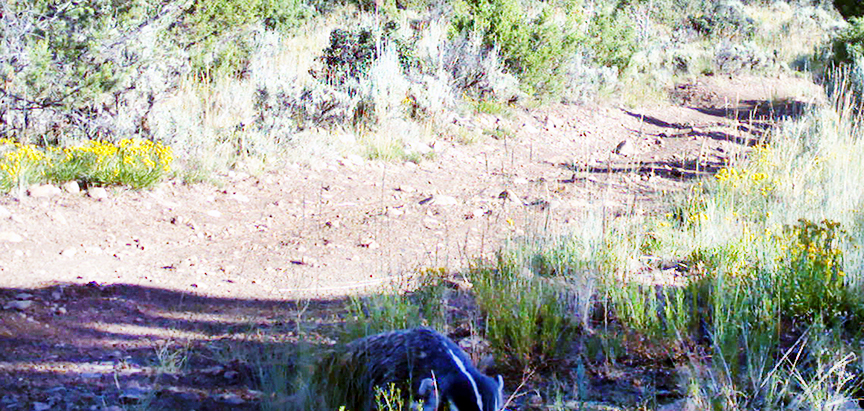Dig this: A badger pops up on open space

A badger, captured on a wildlife camera at Glassier Open Space.
The wild inhabitants of Pitkin County’s open spaces aren’t always obvious, so when something new shows up on a wildlife camera, it’s cause for excitement, even if the animal has always been there. So it was with the first-ever detection of a badger on an open space property.
A wildlife camera at Glassier Open Space photographed half of a badger in late July, prompting Open Space and Trails to set up a couple of additional cameras a bit closer to ground level in the hopes of better glimpse of this intriguing member of the weasel family. One camera monitors what appears to be a badger den on a trail easement near Glassier. No luck yet on the photo front.
The American badger (Taxidea taxus), is not endangered or rare in Colorado, though it may be rarely seen thanks to its largely nocturnal lifestyle. As a weasel, it belongs to a group that also includes the short- and long-tailed weasel, otters, ferrets, martens and wolverines.
Despite their ferocious countenance – long incisors and distinctive, masked face – badgers are not considered a threat to humans as long as humans show proper respect, i.e. don’t approach and make the badger feel threatened. Badgers hiss, growl and bare their teeth in response to perceived danger. Impressively, they are capable of digging a hole with their back feet and disappearing underground even as they face off against an opponent.
“They are not wanton biters, attackers, and killers of children and people,” noted Colorado Parks and Wildlife wildlife manager Craig Wescoatt in an Eagle Outside blog post. Pets are best kept away.
Badgers are nature’s excavators. With long claws and stubby legs, they are the diggers of the animal world, boring for prey and creating extensive burrows. With closed eyes, protected by a third eyelid, a badger digs for rodents using its sense of smell and hearing to guide it in its underground pursuit. Ground squirrels, voles, gophers, marmots and the like make up it its typical diet. Coyotes have been documented working in concert with badgers to hunt, capturing rodents flushed from burrows by a badger, though a coyote’s presence at an exit may work in the badger’s favor, as well, according to researchers. The two animals have been documented engaging in “playful” behavior.
Badgers are mostly solitary creatures, digging new dens frequently, particularly in summer. They stay in a den, or sett, for extended periods during the winter, but aren’t true hibernators. Rather, they enter stages of torpor, a physiological slowdown, for short periods, but emerge on warm winter days. Carrion makes up part of their winter diet.
With few natural enemies, humans and vehicles pose the biggest threat to badgers. Their thick hide and “generally unpleasant disposition” protects them from most predators, according to Colorado Parks and Wildlife, but bobcats, mountain lions, wolves, golden eagles and bears are known to prey on badgers, and foxes will take their young. An average badger litter consists of three cubs, born in March or April. They emerge from the den at 5 to 6 weeks of age and the juveniles typically disperse in late June to August.
A badger’s favored habitat is flat, treeless, open country, including grasslands, farms and ranches with sandy or loamy soils, but they’ve been found at and above timberline in mountainous regions. The oval opening of a badger den is shaped like the animal that created it – wider than it is tall. A badger is about 28 to 32 inches long and weighs roughly 11 to 22 pounds, according to Colorado Parks and Wildlife.
In the Roaring Fork Valley, badgers may have persisted in relatively low numbers previously, but now their population could be on the rise, according to Jonathan Lowsky, wildlife biologist with Colorado Wildlife Science in Basalt. He credits a change in irrigation practices with a resulting ecological shift.
The Wyoming ground squirrel (formerly known as Richardson’s ground squirrel) is a key food source for badgers. Locally, it is frequently mistaken for a prairie dog, but the Wyoming ground squirrel is smaller and a different species altogether. It is distributed throughout Pitkin County.
Flood irrigation precludes ground squirrel habitation as it inundates their burrows with water, but as land managers move away from flood irrigation, the Wyoming ground squirrel population is rebounding. (If you’ve ridden the Cozyline connector trail at Sky Mountain Park, you’ve likely seen the ground squirrels scurrying about.)
Now that ranches and hayfields are being converted to overhead irrigation via sprinkler systems, both Wyoming ground squirrels and badgers are making a comeback, Lowsky theorized. Just this year, a center-pivot irrigation system was installed at Glassier Open Space.
Fortunately, nature in balance means the ground squirrels will keep badgers fed and badgers will keep ground squirrel populations in check.
And more frequent badger sightings might result.
– By Pitkin County Open Space and Trails
KEY LINKS
USDA – Index of Species Information – Taxidea taxus
